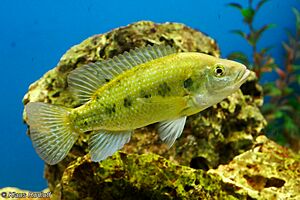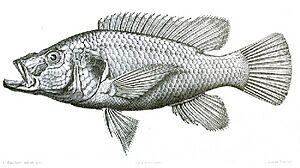Short jaw tristramella facts for kids
Quick facts for kids Short jaw tristramella |
|
|---|---|
 |
|
| In the Tisch Family Zoo, Israel | |
| Conservation status | |
| Scientific classification | |
| Synonyms | |
|
The Tristramella simonis, also known as the short jaw tristramella, is a type of cichlid fish. It lives in the Jordan River system, including Lake Tiberias (also called Kinneret), in Israel and Syria. This fish likes calm waters that don't move much.
People often catch T. simonis for food in some areas. It is an important fish for fishing in Lake Tiberias. However, this fish is now considered a vulnerable species. This means its numbers are decreasing, and it could be in danger of disappearing if we don't protect it.
Contents
Protecting the Short Jaw Tristramella
The short jaw tristramella is the only type of Tristramella fish still alive today. Sadly, it is a vulnerable species, according to the IUCN (International Union for Conservation of Nature).
Why is this Fish in Danger?
The biggest problems for T. simonis are when people take too much water from its rivers and lakes. Climate change also causes less rain in its home areas. Other dangers include too much fishing and a sickness that can make tilapia fish, including T. simonis, go blind.
This fish now lives in fewer than ten places. Its main home is Lake Tiberias, where it used to be very common. Fishing there is usually controlled. However, between 2006 and 2016, the number of T. simonis caught in Lake Tiberias dropped a lot. This was a big change from earlier years.
Even though the numbers went down, young T. simonis fish are still common. This means the population might be able to grow back if conditions improve.
Other Tristramella Fish
Two other types of Tristramella fish, intermidia from Lake Hula and magdelainea from near Damascus, are now extinct. Scientists are still studying if these were separate species or just different kinds of T. simonis.
Interestingly, T. simonis has been found in new places in Syria, like the Nahr al-Kabir and Orontes basins. It is doing well there, even in places made by humans, like reservoirs.
What Does the Short Jaw Tristramella Look Like?
The short jaw tristramella can grow up to about 25.8 centimeters (about 10 inches) long. Most adult fish are usually between 18 and 21 centimeters (about 7 to 8 inches) long.
This fish looks like a typical tilapia. It is usually an olive-brownish or golden-brownish color. Sometimes, it has stripes on its body.
How is it Different from Other Fish?
Compared to the extinct T. sacra (another type of Tristramella fish), T. simonis has a shorter head. Its lower jaw might stick out a little bit, but not as much as T. sacra's. They also have different numbers and shapes of teeth.
Life and Habits of the Short Jaw Tristramella
T. simonis mainly eats tiny plants floating in the water, called phytoplankton. It also eats larger water plants, tiny animals in the water (zooplankton), and small bugs that live on the bottom of lakes.
Where Do They Live?
In Lake Tiberias, adult T. simonis often swim together in large groups in the open water. Young fish, however, stay in safe places near the shore.
Reproduction and Family Life
These fish can start having babies when they are about 16 centimeters (about 6 inches) long. They breed from March to August. A female fish can lay eggs two or three times in one season.
T. simonis is a mouthbrooder. This means the parent (or parents) keeps the eggs and young fish safe inside their mouth. Some people think only the mother does this, while others believe both parents help.
The female lays up to 250 fairly large eggs on the bottom of the lake in a special "nest." This nest is in water less than 3 meters (about 10 feet) deep. Soon after the eggs are laid, a parent picks them up with their mouth. The baby fish stay in the parent's mouth even after they hatch. They only leave when they are about 1.4 centimeters (about half an inch) long.
Unique Facts
Even though different types of tilapia often have babies together (creating hybrids), Tristramella fish do not seem to mix with other tilapias. Also, T. simonis and the now-extinct T. sacra did not have babies together, even though they lived in the same lake.
There is a special type of fish louse, called Argulus tristramellae, that only lives on T. simonis. It does not bother other fish, even the extinct T. sacra when it was still around.



